二万五 TAGS
Long March Independent Space
Location: Long March Space, Beijing (formerly known as 25000 Cultural Transmission Center)
Duration: Dec 17, 2005 – Feb 26, 2006
The Long March Independent Space was established in June 2005 as an open experimental space for art incubation. From 2005 to 2007, 15 exhibitions were held here, including solo exhibitions of various artists including Deng Dafei, Daxiang, Liu Ding, Cui Guangyu, Zheng Shijuan, Ren Xiaoyao, Wang Gongxin, Wang Peng, Li Shurui, Hu Liu, Tang Yi, Chen Jie, Qiu Zhijie, Li Lipeng, Liu Xun, Wen Peng, Wang Wei, Tao Aimin, Rania Ho, Zhao Yue, Li Yang, Zhang Lianxi, etc.
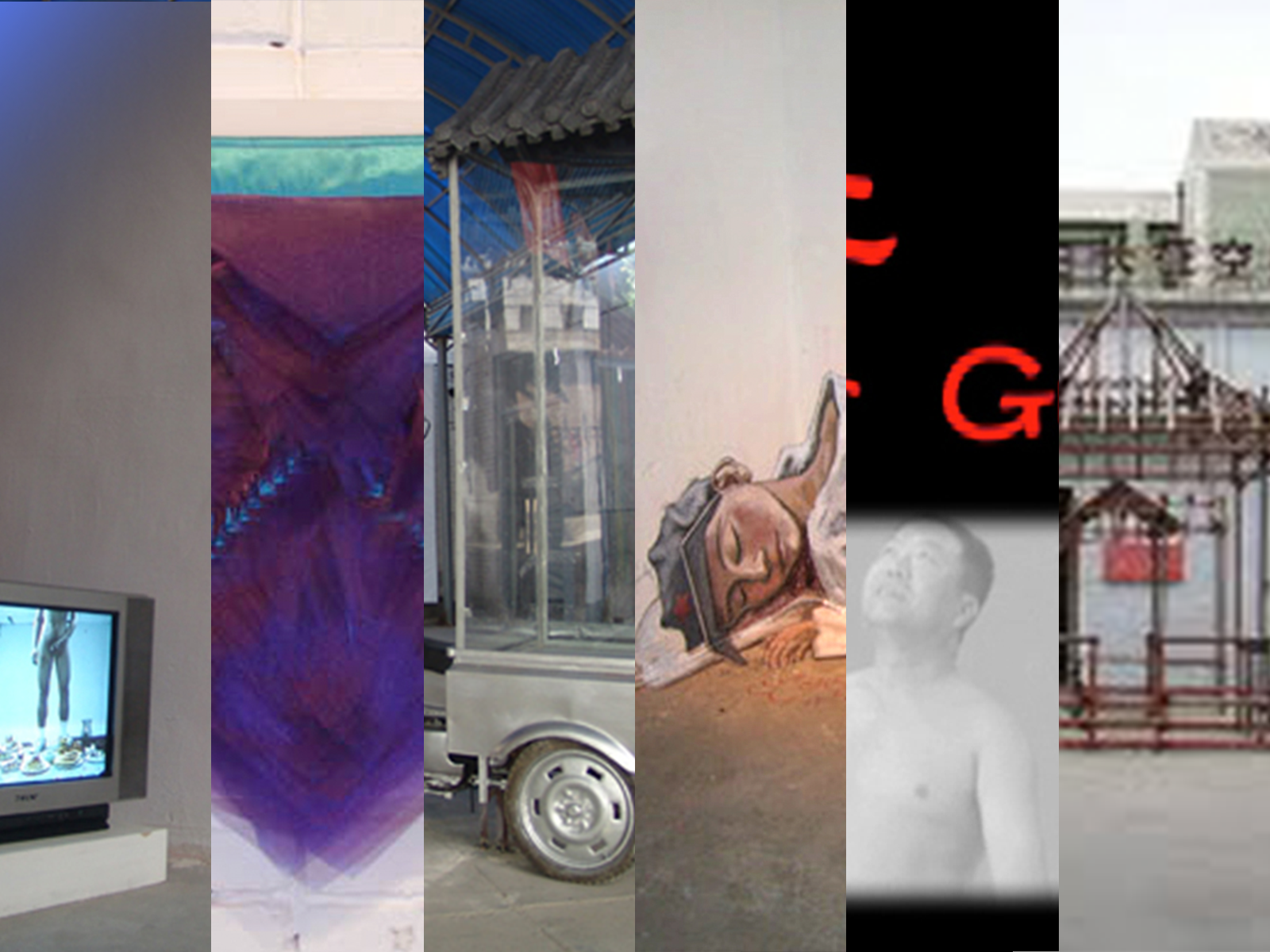
Long March Independent Space
The Long March Independent Space was established in June 2005 as an open experimental space for art incubation. From 2005 to 2007, 15 exhibitions were held here, including solo exhibitions of various artists including Deng Dafei, Daxiang, Liu Ding, Cui Guangyu, Zheng Shijuan, Ren Xiaoyao, Wang Gongxin, Wang Peng, Li Shurui, Hu Liu, Tang Yi, Chen Jie, Qiu Zhijie, Li Lipeng, Liu Xun, Wen Peng, Wang Wei, Tao Aimin, Rania Ho, Zhao Yue, Li Yang, Zhang Lianxi, etc.
Da Xiang, Da Fei: Launch
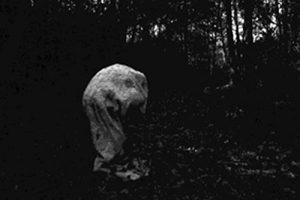
“Da Xiang, Da Fei: Launch”, 2005.6.1 – 6.30, Long March Independent Space, Beijing
Launch” is the first project in realized in the Long March – Independent Project Space. It is an exhibition by the Flying Artist Group. The term “Launch” connotes both a vanguard action as well as an emergence.
The work, “Receipts”, by artist Da Xiang uses the “secretions” of contemporary consumer process (three types of receipts) as its primary element. Borrowing upon the stylistic form of Chinese scroll painting, the work visualizes and cultures the receipts, enlarging the detailed portions of the consumption process, as well as blurring the lines between the installation and documentation.
Artist Da Fei’s work “China Astronaut 9” is a distorted type of beetle-like behavior. In the work, the artist kicks a giant ball of yarn around scenic sites throughout the city, unfolding a diligence and persistence. The technological connotations of the astronaut and the bodily expenditures created by his movements create a mutual connection between past and future, “evolving” a type of linear temporal displacement.
Flying Artist Group is excited to be presenting at the Long March Independent Project Space for the inaugural “Launch” and would like to thank the members of the Long March staff for their support and assistance. We hope that you, the audience, are able to subliminally smell the “secretions” and sense our “Evolutionary Story”.
Liu Ding: Treasure
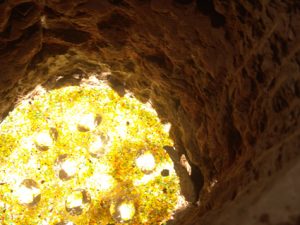
“Liu Ding: Treasure”, 2005.7.23 – 8.17, Long March Independent Space, Beijing
“Samples from the Transition” is a sequence of works I conceptualize as a way to continuously examine and contemplate the various aspects of contemporary society on a microcosmic level. They are the results from my attempts to re-interpret, represent and magnify the all kinds of contradictions, absurd events, bizarre phenomena, and outrageous concepts prevalent in the society today. As I carefully obscure the borderlines between the existing order and disorder, the logical and the incredible, and highlight the confusion, disharmony, complication, the out of place and the absurd in my projection of the reality from various perspectives, the audience is led to experience alienation, uneasiness and confusion over the common way of life that they are familiar to.
Along the same cultural vein, any type of living condition and social discourse are conditioned and shaped by the specific era they are in. The overall climate of an era also determines the style, attribute and tone of artworks produced in this timeframe. Especially in this chaotic and turbulent decade we are in today, the exclusiveness and importance of an individual are pushed aside to the margin by the different social currents of our times. Living in these rootless “troubled times,” the insignificance of an individual stands out even more, constantly reminding us of our vulnerable position. The overall aesthetics, sentiments, ethical guidelines, value standards, and worldview of the era prevail over everything. It is impossible to distinguish bubble from reality. We have no way of escaping the bastion of iron made with false standards. On the other hand, artworks that sample from the reality and reflect on, question, and discuss relevant social practice and social issues bear the marks of our times in many aspects.
In many historical images and memories, the great person would always be standing on top of a mountain, overlooking and pointing out to the world under his feet. The mountaintop thus comes to be considered a synonym for power. In the world of Alibaba, the treasure is always hidden in the depth of the mountain. If you venture there and obtain the password, you can then get your hands on the treasure. Power and treasure seem to be out of reach but in the meantime, they might be just around the corner. In reality, many of us are fully committed to being a player in this Vanity Fair, full of ambitions and desires. We all hope that one day we could reach the peak of the mountain and we would do it at any cost, and by any means. Some people thus become workaholics; some become a visionary of the new age by making “flying machines;” some become profitable psychiatrists and gym bosses; some become artists who reflect on this mass “hiking” movement in the society. What would happen then once we reach the top of a mountain? Is there really priceless treasure or simply a fantasy of ours? Besides, there are always higher mountains beyond the ones we’ve conquered. Is there an end to this venture?
As clouds gather and wind grows stronger, it can get very difficult to steady oneself on a tiny bit of land on the mountaintop. But despite the constant changes of climate, the mountaintop is forever a source of temptation attracting people to surge there, as butterflies are drawn to fire. Perhaps there is really a lot of “visible” treasure!
Specifications and Materials
To find the central point on the floor of an independent rectangular space and dig a 250 cm deep opening. To install an ultra bright spotlight on the bottom of this opening so that the light can come out through the pile of jewelries placed on the top. The remains from the digging are kept around the opening.
Materials
Ultra bright spotlight and manmade gems.
Cui Guangyu, Zheng Shixiu: Easy Come Easy Go
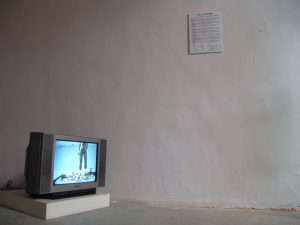
“Cui Guangyu, Zheng Shixiu: Easy Come Easy Go”, 2005.8.20 – 9.11, Long March Independent Space, Beijing, Curator: Yao Juichung
Since 2000, the development of performance art in Taiwan, aside from being driven by an annual performance art festival, is also driven by a different and new sub-current that uses video to conduct and elaborate upon performance. These artists are not merely interested in the active creative attitudes that performance art brings to the table, but are more interested in using personal experiences as a means to test all the possibilities of body and spirit.
From the basic appearance of these works, is become apparent that a new generation of artist is forming. The social and historical introspection and criticism of the early 1990’s has already turned into a focus on individual monologues and soliloquies. These works are not particularly interested in discussing any social problems – there is simply not much interest in the Utopian concept of art reforming society -rather it is the individual and the absurdity of existence which been gaining much attention, as can be seen from the large amount of works which utilize popular media, internet, video games, and other new mediums and video.
However, in a consumerist age dominated by media, what is the essence of real life? Aside from retreating into personal space, some works also reveal an easy going play like attitude. These works are not particularly interested in site specific performance, but rather using the visual expression of video and space to display the possibilities of the combination between conceptualism and performance.
This type of creation is not about using video to “re-show” a certain performance, nor is it a public declaration. Rather, the works use the method of video to first record, edit, and cut the video in order to express a certain type of bodily state and context. This exhibition is a selection of works from two young artists, the simplicity of their creative attitudes seem a little without reason, their laughing in playing in a moment is perhaps a game, it is filled with doubt about the region of existence and the value of the individual. But concealed within the works helplessness and grieved portions is also an absurd use of the body, pointing to an even greater absurdity to which it corresponds.
If one were to say that helplessness is a sham within this period we call life, the fortunes of the younger generation have to do with how they can reach this region and express it. Like I once said, “The historical fate of man is filled with an incurable absurdity.” It was before, it is now, and it will be so later, there is no way to escape this unnamable and indescribable state of absurdity.
Wang Gongxin: Er Guo Tou
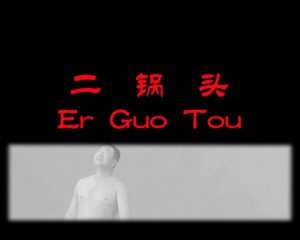
“Wang Gongxin: Er Guo Tou”, 2005.9.17 – 10.9, Long March Independent Space, Beijing
The latest work by Wang Gongxin entitled… “Erguotou! Old fellows, our beloved Erguotou. One sip courses through your entire body, gives you all the confidence you need. After a bottle…well, nothing in this world can scare you. Let me take advantage of our drinking to tell you a little joke…”
Wang Peng: Movement

“Wang Peng: Movement”, 2005.9.17 – 10.9, Long March Independent Space, Beijing
The base of the piece is provided by a motorized tricycle, a ubiquitous mode of cheap transportation for goods and people in China. Its exhaust fumes channeled to and trapped by a tall glass house on its back to be slowly dissipated by a small opening at the top.
Wang has produced a potent symbol of the contradictions plaguing China, capturing in a simple set-up the logical and emotional flux within the dynamics of the urban zeitgeist.
Li Shurui: Exceeding Size…
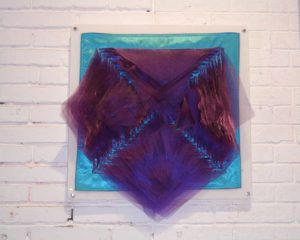
“Li Shurui: Exceeding Size…”, 2005.10.23 – 11.9, Long March Independent Space, Beijing
“Exceeding Size…” is a proposal that I had let lie for the past year. With generous support from the Long March Space, this work will finally be presented here for the next two weeks. This exhibition will be followed by exhibitions by my friends Hu Liu, Tang Yi, and Chen Jiechu.
The three works presented are the most exquisite works I have produced to date. The materials used are textile and plexi-glass, and the simple structure and small size enable you to view the work in its entirety from the doorstep. The works are very much like some life-form meaninglessly reproducing themselves inside the glass mantles, but also a materialization of extreme simplicity in my own aesthetic viewpoint. I hope to represent a transforming scene to show how reproducing and replicating become a part of physiological process.
Hu Liu: One One

“Hu Liu: One One”, 2005.11.1 – 11.28, Long March Independent Space, Beijing
On a small platform in the middle of the space, place a different thing on it everyday. Have a lantern lit and hanged in the middle of the ceiling, block the sunlight outside with a gobo in the entrance.
Tang Yi: Lemon Drop
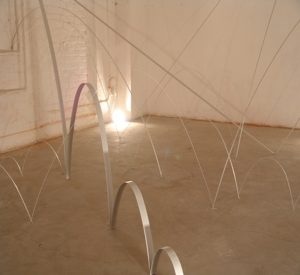
“Tang Yi: Lemon Drop”, 2005.12.1 – 12.20, Long March Independent Space, Beijing
Determining the force, speed and direction or an object in motion, or to determine how a conceptual object should be made visible is not necessarily anymore difficult the task of navigating our reality. There are numerous factors that must be accounted for in this determination; position, mass, volume, density, rigidity, elasticity, friction, gravity, altitude, magnetism, pressure, wind…all of which act upon our small ball continuously from the moment that we release it. However, the laws of perpetual motion means that it is destined to touch the ground, forming a relationship to this earth and getting stained. In the age of science people are driven towards a creation of every greater precision, so that the limit approaches zero. However, art deeply aspires to the irrational and unpredictable events of the quotidian.
If one were to pick out one or two chance happenings from the numerous occurrences around us, a geometrical calculation would be performed with which to trace out the clumsiness of humankind. In the flowing line of a parabola, calculating comes as a much easier process than other forms of forgery. Choosing a curve is less dramatic than choosing a reason within a space. At any point along it, from its base to the tops of any of its undulating curves, all hint at the possibility of a sleek passing of the future. Highly and poetically – coolly and without hesitation, the curve moves imperturbably and solidly finally ending in an almost perfectly straight descent. What awaits it is an indeterminable resistance and friction. One can only try harder to accurately understand this geometrical world, or to find another method to solve these metaphysical riddle of these crude and high waves undulate chaotically and frenetically until ending in a perfectly straight line. This is not simply a classic example of a story about “extinguishment,” rather it is a poetically expressive physics – occurring in this world where we are all accustomed to being helplessly consumed and debilitated.
Chen Jie: Untitled

“Chen Jie: Untitled”, 2005.12.21 – 2006.1.9, Long March Independent Space, Beijing
I remove myself from the frivolous games of ontological quibbles surrounding painting. If not, then it would only make it appear even more violent. To smear paint is itself a rather ambiguous activity, one which repeatedly emphasizes the unequal dividends attributed to the image and the labor of painting, which is of great injury to both human rights as well as material rights.
The act of painting is an exchange between material image and human. It is an illusion of exchanging labor for the psychological rush of creation, a more refined method for the expression of material fetish. It is sticky substance and a program bug that cannot be made to rectify. All things begin from eros and will turn beautiful and peaceful.
The re-appearance of a material image – whose identity is that of being painted upon – within a strange place is not only a hidden material fetish, in the name of eros, it takes all of the injuries and conceals them within the frame of the painting, and is hung before the wall.
Li Yang: Wake Up
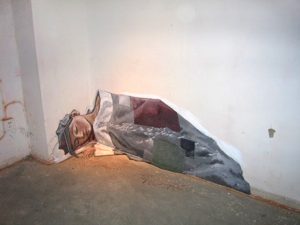
“Li Yang: Wake Up”, 2006.1.10 – 2.26, Long March Independent Space, Beijing
One day one year… I went to join the Long March on the road, only it seemed I was by myself. I got so exhausted that I fell asleep in a huge auditorium. When I woke up; I thought that if there was only an alarm clock I could find everyone else…
From diary of my dreams, Li Yang
Zhao Yue: Six Photos and a Small Room

“Zhao Yue: Six Photos and a Small Room”, 2006.3.4 – 3.31, Long March Independent Space, Beijing
I’ve always been infatuated with calligraphy’s perfect development in time and the overlap in space, which urges me to find out more possibilities for photography in both multi-temporal and spatial engagement. Calligraphy and photography are both an act of superposing different temporal and spatial movement in a planar media, but calligraphy is superior to photography in its integrality and naturalness. This series “One Month One Day in 2005” consists of several random snapshots of scenes in normal life. When placed together, they use time to construct a space, and with the satirizing of time through space, convey a new meaning to the significance of time. The intention is to use a new method of dealing with space and time to create both conscious and unconscious misreadings. As for the stripes in the small room, they are a simple visual means to distort the physical space, creating a resonance with the
distorted temporal space within the photographs.
He Yingyi: Time Stamp
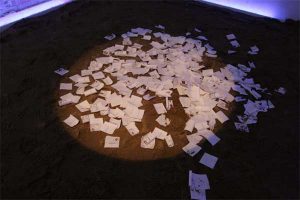
“He Yingyi: Time Stamp”, 2006.4.8 – 4.30, Long March Independent Space, Beijing
Tao Aimin: A Woman’s Long March

“Tao Aimin: A Woman’s Long March”, 2006.5.6 – 6.4, Long March Independent Space, Beijing
A woman walks along the road, as if she is traversing time itself. The sharp edges of this collection of washboards have long been worn down, worn until all that is left are mottled traces of the ridges once there. Throughout their journeys, the owners of these washboards have experienced trials and hardships, tribulations and suffering, but their spirits persevere. Using art to chronicle their journeys is, in ways, akin to putting their histories down in writing. This is a life course filled with passion, a road in the long march of life.
Video Installation: Explanation of Work
The materials of this work are composed of over a hundred and sixty old washboards used by generations of Chinese women. To this day, many rural woman still use washboards—these ordinary everyday household objects—to do their laundry. The faces of the owners, some of whom are over 90 years old, are painted on some of the washboards. It is not an exaggeration to say that these women have spent half their lives bent over these boards, washing clothes for their families. The worn-down grooves of the washboards and lines a life of labor has left on their faces become almost indistinguishable. Each and every one bears the marks of its owners life, telling us stories from her life.
The video component of the piece was filmed during the process of collecting the washboards that began with the discovery of one mother’s washboard. During the course of the project, I also collected the life stories and memories of each woman, took their pictures and spent time experiencing the genuine conditions of their lives. On the road, during the process of making the piece, I experienced loneliness and hardship, but still felt a kind of inner peace. It was as if this was also a process of seeking myself as well.
Lu Xun, Wen Peng, Wang We: Strange Sights
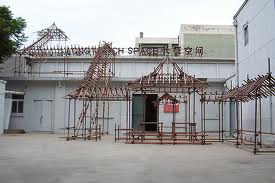
“Long March Independent Project: Strange Sights”, Lu Xun, Wen Peng, Wang Wei, 2006.6.10 – 7.9, Long March Independent Space, Beijing
Qiu Zhijie, Li Lipeng: Magnetic Erasure Space

“Long March Space Independent Project: Magnetic Erasure Space” , Qiu Zhijie, Li Lipeng, 2006.7.23, Long March Independent Space, Beijing
What do we take with us when we head out? Where do we dare not to go? We lose, because we have once owned. We will be forgotten, because we have once been remembered. We live a busy, substantial, doubtless, but anxious life, identified by numbers, symbols, channels and locations. We are always trying to avoid a certain place, one that could hurt us who are modern. Like a pawn waiting to be taken. Magnetic Erasure Space is a restricted area. Magnetic Erasure Space is a space of leisure. Magnetic Erasure Space has something to do with Fengshui.
Zhang Lianxi: Paradox

“Zhang Lianxi: Paradox”, 2007.8.18 – 9.9, Long March Independent Space, Beijing
This video recorded the small ordinary lives around us. By filming them, I reflected the conflict between the human being and the tiny ordinary lives, also the evil actions done by mankind and the consequence. But I found the whole process of filming is like a self-mockery and a paradox. Therefore, I could not tell the good and evil, maybe all the happenings are just for the matter of “existence”.
Long March Independent Space
The Long March Independent Space was established in June 2005 as an open experimental space for art incubation. From 2005 to 2007, 15 exhibitions were held here, including solo exhibitions of various artists including Deng Dafei, Daxiang, Liu Ding, Cui Guangyu, Zheng Shijuan, Ren Xiaoyao, Wang Gongxin, Wang Peng, Li Shurui, Hu Liu, Tang Yi, Chen Jie, Qiu Zhijie, Li Lipeng, Liu Xun, Wen Peng, Wang Wei, Tao Aimin, Rania Ho, Zhao Yue, Li Yang, Zhang Lianxi, etc.
Da Xiang, Da Fei: Launch

“Da Xiang, Da Fei: Launch”, 2005.6.1 – 6.30, Long March Independent Space, Beijing
Launch” is the first project in realized in the Long March – Independent Project Space. It is an exhibition by the Flying Artist Group. The term “Launch” connotes both a vanguard action as well as an emergence.
The work, “Receipts”, by artist Da Xiang uses the “secretions” of contemporary consumer process (three types of receipts) as its primary element. Borrowing upon the stylistic form of Chinese scroll painting, the work visualizes and cultures the receipts, enlarging the detailed portions of the consumption process, as well as blurring the lines between the installation and documentation.
Artist Da Fei’s work “China Astronaut 9” is a distorted type of beetle-like behavior. In the work, the artist kicks a giant ball of yarn around scenic sites throughout the city, unfolding a diligence and persistence. The technological connotations of the astronaut and the bodily expenditures created by his movements create a mutual connection between past and future, “evolving” a type of linear temporal displacement.
Flying Artist Group is excited to be presenting at the Long March Independent Project Space for the inaugural “Launch” and would like to thank the members of the Long March staff for their support and assistance. We hope that you, the audience, are able to subliminally smell the “secretions” and sense our “Evolutionary Story”.
Liu Ding: Treasure

“Liu Ding: Treasure”, 2005.7.23 – 8.17, Long March Independent Space, Beijing
“Samples from the Transition” is a sequence of works I conceptualize as a way to continuously examine and contemplate the various aspects of contemporary society on a microcosmic level. They are the results from my attempts to re-interpret, represent and magnify the all kinds of contradictions, absurd events, bizarre phenomena, and outrageous concepts prevalent in the society today. As I carefully obscure the borderlines between the existing order and disorder, the logical and the incredible, and highlight the confusion, disharmony, complication, the out of place and the absurd in my projection of the reality from various perspectives, the audience is led to experience alienation, uneasiness and confusion over the common way of life that they are familiar to.
Along the same cultural vein, any type of living condition and social discourse are conditioned and shaped by the specific era they are in. The overall climate of an era also determines the style, attribute and tone of artworks produced in this timeframe. Especially in this chaotic and turbulent decade we are in today, the exclusiveness and importance of an individual are pushed aside to the margin by the different social currents of our times. Living in these rootless “troubled times,” the insignificance of an individual stands out even more, constantly reminding us of our vulnerable position. The overall aesthetics, sentiments, ethical guidelines, value standards, and worldview of the era prevail over everything. It is impossible to distinguish bubble from reality. We have no way of escaping the bastion of iron made with false standards. On the other hand, artworks that sample from the reality and reflect on, question, and discuss relevant social practice and social issues bear the marks of our times in many aspects.
In many historical images and memories, the great person would always be standing on top of a mountain, overlooking and pointing out to the world under his feet. The mountaintop thus comes to be considered a synonym for power. In the world of Alibaba, the treasure is always hidden in the depth of the mountain. If you venture there and obtain the password, you can then get your hands on the treasure. Power and treasure seem to be out of reach but in the meantime, they might be just around the corner. In reality, many of us are fully committed to being a player in this Vanity Fair, full of ambitions and desires. We all hope that one day we could reach the peak of the mountain and we would do it at any cost, and by any means. Some people thus become workaholics; some become a visionary of the new age by making “flying machines;” some become profitable psychiatrists and gym bosses; some become artists who reflect on this mass “hiking” movement in the society. What would happen then once we reach the top of a mountain? Is there really priceless treasure or simply a fantasy of ours? Besides, there are always higher mountains beyond the ones we’ve conquered. Is there an end to this venture?
As clouds gather and wind grows stronger, it can get very difficult to steady oneself on a tiny bit of land on the mountaintop. But despite the constant changes of climate, the mountaintop is forever a source of temptation attracting people to surge there, as butterflies are drawn to fire. Perhaps there is really a lot of “visible” treasure!
Specifications and Materials
To find the central point on the floor of an independent rectangular space and dig a 250 cm deep opening. To install an ultra bright spotlight on the bottom of this opening so that the light can come out through the pile of jewelries placed on the top. The remains from the digging are kept around the opening.
Materials
Ultra bright spotlight and manmade gems.
Cui Guangyu, Zheng Shixiu: Easy Come Easy Go

“Cui Guangyu, Zheng Shixiu: Easy Come Easy Go”, 2005.8.20 – 9.11, Long March Independent Space, Beijing, Curator: Yao Juichung
Since 2000, the development of performance art in Taiwan, aside from being driven by an annual performance art festival, is also driven by a different and new sub-current that uses video to conduct and elaborate upon performance. These artists are not merely interested in the active creative attitudes that performance art brings to the table, but are more interested in using personal experiences as a means to test all the possibilities of body and spirit.
From the basic appearance of these works, is become apparent that a new generation of artist is forming. The social and historical introspection and criticism of the early 1990’s has already turned into a focus on individual monologues and soliloquies. These works are not particularly interested in discussing any social problems – there is simply not much interest in the Utopian concept of art reforming society -rather it is the individual and the absurdity of existence which been gaining much attention, as can be seen from the large amount of works which utilize popular media, internet, video games, and other new mediums and video.
However, in a consumerist age dominated by media, what is the essence of real life? Aside from retreating into personal space, some works also reveal an easy going play like attitude. These works are not particularly interested in site specific performance, but rather using the visual expression of video and space to display the possibilities of the combination between conceptualism and performance.
This type of creation is not about using video to “re-show” a certain performance, nor is it a public declaration. Rather, the works use the method of video to first record, edit, and cut the video in order to express a certain type of bodily state and context. This exhibition is a selection of works from two young artists, the simplicity of their creative attitudes seem a little without reason, their laughing in playing in a moment is perhaps a game, it is filled with doubt about the region of existence and the value of the individual. But concealed within the works helplessness and grieved portions is also an absurd use of the body, pointing to an even greater absurdity to which it corresponds.
If one were to say that helplessness is a sham within this period we call life, the fortunes of the younger generation have to do with how they can reach this region and express it. Like I once said, “The historical fate of man is filled with an incurable absurdity.” It was before, it is now, and it will be so later, there is no way to escape this unnamable and indescribable state of absurdity.
Wang Gongxin: Er Guo Tou

“Wang Gongxin: Er Guo Tou”, 2005.9.17 – 10.9, Long March Independent Space, Beijing
The latest work by Wang Gongxin entitled… “Erguotou! Old fellows, our beloved Erguotou. One sip courses through your entire body, gives you all the confidence you need. After a bottle…well, nothing in this world can scare you. Let me take advantage of our drinking to tell you a little joke…”
Wang Peng: Movement

“Wang Peng: Movement”, 2005.9.17 – 10.9, Long March Independent Space, Beijing
The base of the piece is provided by a motorized tricycle, a ubiquitous mode of cheap transportation for goods and people in China. Its exhaust fumes channeled to and trapped by a tall glass house on its back to be slowly dissipated by a small opening at the top.
Wang has produced a potent symbol of the contradictions plaguing China, capturing in a simple set-up the logical and emotional flux within the dynamics of the urban zeitgeist.
Li Shurui: Exceeding Size…

“Li Shurui: Exceeding Size…”, 2005.10.23 – 11.9, Long March Independent Space, Beijing
“Exceeding Size…” is a proposal that I had let lie for the past year. With generous support from the Long March Space, this work will finally be presented here for the next two weeks. This exhibition will be followed by exhibitions by my friends Hu Liu, Tang Yi, and Chen Jiechu.
The three works presented are the most exquisite works I have produced to date. The materials used are textile and plexi-glass, and the simple structure and small size enable you to view the work in its entirety from the doorstep. The works are very much like some life-form meaninglessly reproducing themselves inside the glass mantles, but also a materialization of extreme simplicity in my own aesthetic viewpoint. I hope to represent a transforming scene to show how reproducing and replicating become a part of physiological process.
Hu Liu: One One

“Hu Liu: One One”, 2005.11.1 – 11.28, Long March Independent Space, Beijing
On a small platform in the middle of the space, place a different thing on it everyday. Have a lantern lit and hanged in the middle of the ceiling, block the sunlight outside with a gobo in the entrance.
Tang Yi: Lemon Drop

“Tang Yi: Lemon Drop”, 2005.12.1 – 12.20, Long March Independent Space, Beijing
Determining the force, speed and direction or an object in motion, or to determine how a conceptual object should be made visible is not necessarily anymore difficult the task of navigating our reality. There are numerous factors that must be accounted for in this determination; position, mass, volume, density, rigidity, elasticity, friction, gravity, altitude, magnetism, pressure, wind…all of which act upon our small ball continuously from the moment that we release it. However, the laws of perpetual motion means that it is destined to touch the ground, forming a relationship to this earth and getting stained. In the age of science people are driven towards a creation of every greater precision, so that the limit approaches zero. However, art deeply aspires to the irrational and unpredictable events of the quotidian.
If one were to pick out one or two chance happenings from the numerous occurrences around us, a geometrical calculation would be performed with which to trace out the clumsiness of humankind. In the flowing line of a parabola, calculating comes as a much easier process than other forms of forgery. Choosing a curve is less dramatic than choosing a reason within a space. At any point along it, from its base to the tops of any of its undulating curves, all hint at the possibility of a sleek passing of the future. Highly and poetically – coolly and without hesitation, the curve moves imperturbably and solidly finally ending in an almost perfectly straight descent. What awaits it is an indeterminable resistance and friction. One can only try harder to accurately understand this geometrical world, or to find another method to solve these metaphysical riddle of these crude and high waves undulate chaotically and frenetically until ending in a perfectly straight line. This is not simply a classic example of a story about “extinguishment,” rather it is a poetically expressive physics – occurring in this world where we are all accustomed to being helplessly consumed and debilitated.
Chen Jie: Untitled

“Chen Jie: Untitled”, 2005.12.21 – 2006.1.9, Long March Independent Space, Beijing
I remove myself from the frivolous games of ontological quibbles surrounding painting. If not, then it would only make it appear even more violent. To smear paint is itself a rather ambiguous activity, one which repeatedly emphasizes the unequal dividends attributed to the image and the labor of painting, which is of great injury to both human rights as well as material rights.
The act of painting is an exchange between material image and human. It is an illusion of exchanging labor for the psychological rush of creation, a more refined method for the expression of material fetish. It is sticky substance and a program bug that cannot be made to rectify. All things begin from eros and will turn beautiful and peaceful.
The re-appearance of a material image – whose identity is that of being painted upon – within a strange place is not only a hidden material fetish, in the name of eros, it takes all of the injuries and conceals them within the frame of the painting, and is hung before the wall.
Li Yang: Wake Up

“Li Yang: Wake Up”, 2006.1.10 – 2.26, Long March Independent Space, Beijing
One day one year… I went to join the Long March on the road, only it seemed I was by myself. I got so exhausted that I fell asleep in a huge auditorium. When I woke up; I thought that if there was only an alarm clock I could find everyone else…
From diary of my dreams, Li Yang
Zhao Yue: Six Photos and a Small Room

“Zhao Yue: Six Photos and a Small Room”, 2006.3.4 – 3.31, Long March Independent Space, Beijing
I’ve always been infatuated with calligraphy’s perfect development in time and the overlap in space, which urges me to find out more possibilities for photography in both multi-temporal and spatial engagement. Calligraphy and photography are both an act of superposing different temporal and spatial movement in a planar media, but calligraphy is superior to photography in its integrality and naturalness. This series “One Month One Day in 2005” consists of several random snapshots of scenes in normal life. When placed together, they use time to construct a space, and with the satirizing of time through space, convey a new meaning to the significance of time. The intention is to use a new method of dealing with space and time to create both conscious and unconscious misreadings. As for the stripes in the small room, they are a simple visual means to distort the physical space, creating a resonance with the
distorted temporal space within the photographs.
He Yingyi: Time Stamp

“He Yingyi: Time Stamp”, 2006.4.8 – 4.30, Long March Independent Space, Beijing
Tao Aimin: A Woman’s Long March

“Tao Aimin: A Woman’s Long March”, 2006.5.6 – 6.4, Long March Independent Space, Beijing
A woman walks along the road, as if she is traversing time itself. The sharp edges of this collection of washboards have long been worn down, worn until all that is left are mottled traces of the ridges once there. Throughout their journeys, the owners of these washboards have experienced trials and hardships, tribulations and suffering, but their spirits persevere. Using art to chronicle their journeys is, in ways, akin to putting their histories down in writing. This is a life course filled with passion, a road in the long march of life.
Video Installation: Explanation of Work
The materials of this work are composed of over a hundred and sixty old washboards used by generations of Chinese women. To this day, many rural woman still use washboards—these ordinary everyday household objects—to do their laundry. The faces of the owners, some of whom are over 90 years old, are painted on some of the washboards. It is not an exaggeration to say that these women have spent half their lives bent over these boards, washing clothes for their families. The worn-down grooves of the washboards and lines a life of labor has left on their faces become almost indistinguishable. Each and every one bears the marks of its owners life, telling us stories from her life.
The video component of the piece was filmed during the process of collecting the washboards that began with the discovery of one mother’s washboard. During the course of the project, I also collected the life stories and memories of each woman, took their pictures and spent time experiencing the genuine conditions of their lives. On the road, during the process of making the piece, I experienced loneliness and hardship, but still felt a kind of inner peace. It was as if this was also a process of seeking myself as well.
Lu Xun, Wen Peng, Wang We: Strange Sights

“Long March Independent Project: Strange Sights”, Lu Xun, Wen Peng, Wang Wei, 2006.6.10 – 7.9, Long March Independent Space, Beijing
Qiu Zhijie, Li Lipeng: Magnetic Erasure Space

“Long March Space Independent Project: Magnetic Erasure Space” , Qiu Zhijie, Li Lipeng, 2006.7.23, Long March Independent Space, Beijing
What do we take with us when we head out? Where do we dare not to go? We lose, because we have once owned. We will be forgotten, because we have once been remembered. We live a busy, substantial, doubtless, but anxious life, identified by numbers, symbols, channels and locations. We are always trying to avoid a certain place, one that could hurt us who are modern. Like a pawn waiting to be taken. Magnetic Erasure Space is a restricted area. Magnetic Erasure Space is a space of leisure. Magnetic Erasure Space has something to do with Fengshui.
Zhang Lianxi: Paradox

“Zhang Lianxi: Paradox”, 2007.8.18 – 9.9, Long March Independent Space, Beijing
This video recorded the small ordinary lives around us. By filming them, I reflected the conflict between the human being and the tiny ordinary lives, also the evil actions done by mankind and the consequence. But I found the whole process of filming is like a self-mockery and a paradox. Therefore, I could not tell the good and evil, maybe all the happenings are just for the matter of “existence”.
